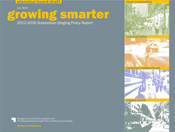2012 Subdivision Staging Policy
The latest version of Montgomery County’s Subdivision Staging Policy is being updated for review and approval by the County Council by November 15, 2016. Learn more
The County Council has adopted the 2012 Subdivision Staging Policy, which ensures that transportation and school capacity — as well as water and sewer and other infrastructure — will keep pace with growth.
This quadrennial policy includes criteria and guidance for the administration of the Adequate Public Facilities Ordinance (APFO), which matches the timing of private development with the availability of public services.
Reports
The County Council made significant changes to the Planning Board draft. See the adopted resolution for the Council’s final action.
View the 2012 Subdivision Staging Policy Planning Board Draft [PDF](pdf, 2.7MB), recommended by the Planning Board on July 26, 2012. Read the press release.
2012-2016 Subdivision Staging Policy Appendix
Appendix 1: Pace and Pattern of Development [PDF] (pdf, 1.0 MB)
Appendix 2: TPAR report [PDF](pdf, 15.1 MB)
Appendix 3: Developer Contributions to Infrastructure [PDF](pdf, 1.7 MB)
Appendix 4: School Capacity Forecasting [PDF](pdf, 725 KB)
Appendix 5: Resolution draft [PDF](pdf, 6.3 MB)
Transportation Tests
Transportation tests in the Subdivision Staging Policy balance the number of trips against the transportation infrastructure – transit, roads and pedestrian/cycling routes. See the latest LATR/TPAR report.
Transportation Policy Area Review (TPAR)
This strategy measures the impacts of development on traffic flow and transit capacity in each of the county’s 30 traffic policy areas. TPAR establishes standards for roadway and transit adequacy and determines which policy areas meet those standards.
TPAR sets different standards for transportation adequacy in urban, suburban and rural areas. If development is proposed in a policy area that does not meet the roadway or transit standards, the development must provide the needed capacity or make a TPAR payment.
- New! View the 2015 Transportation Policy Area Review (TPAR) Update [PDF]
- View the resolutionestablishing the TPAR payment schedule based on the adequacy of the policy area.
- View the 2012 Transportation Policy Area Review: A Synopsis of the Area-wide Transportation Test.[PDF] (pdf, 5MB)
TPAR roadway adequacy
TPAR roadway analysis uses a regional travel demand model to assess the adequacy of main roads in the peak direction of travel during the PM peak hour. Results are expressed for each of the major roadways in terms of Level of Service (LOS) from A to F, with LOS A representing free-flowing traffic and LOS F representing gridlock. Transportation planners and engineers consider traffic operating in LOS D conditions during PM peak optimal for an efficient road network and good use of resources in a suburban area.
TPAR transit adequacy
TPAR transit analysis considers three facets of existing local bus transit service: Service Coverage, Peak Headways, and Span of Service. All three metrics must meet the established standards for a policy area to be considered adequate for transit.
- Service Coverage measures the percentage of the policy area that lies within one-third mile of transit services such as bus routes.
- Analysis of Peak Headways measures the average time between arrival of transit vehicles at a stop during PM peak hours.
- Span of Service looks at the transit system’s hours of operation.
Local Area Transportation Review (LATR)
A localized test, the Local Area Transportation Review (LATR) is used by planners reviewing applications to determine whether to require a traffic study. The Planning Board will only approve a subdivision if the LATR test finds the project, (including transportation improvements, if necessary) will not create unacceptable congestion. Some changes to the LATR standards were adopted in the Subdivision Staging Policy by the County Council. Development that projects Critical Lane Volumes of 1,600 or greater will be required to do additional analysis in accordance with the 2010 Highway Capacity Manual. These changes will be incorporated into the guideines implementing the LATR along with process improvements that will be considered by the Planning Board in early 2013.
See the memo [PDF] that documents the results of a national survey of the traffic impact study practices of Montgomery County peer jurisdictions.
School Capacity

School adequacy is determined for each school level: elementary, middle and high, based on school population projections provided by Montgomery County Public Schools. If projected school enrollment at any level exceeds 105 percent of projected school capacity [PDF], residential development within the affected school cluster will be required to make a school facility payment. [PDF]
Background
Learn more about the SSP and what it means for Montgomery County.
